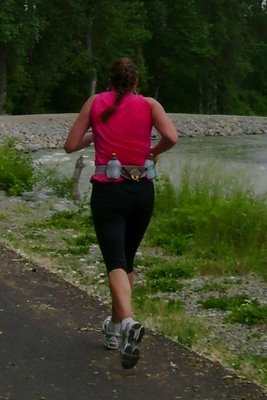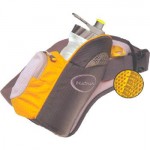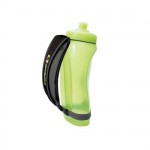 by Scott Dickey – SLRC Employee
by Scott Dickey – SLRC Employee
Long runs can be quite daunting. Not just the mileage all at once, but the logistics that go into to making it a successful, stress free run. With a little planning, your long runs can become a positive experience that you will no longer dread.
The first thing you need to do is tell someone how long you will be gone and your general route. That way if anything happens, they know when and where to look. Also in case of an emergency you should carry a phone. Some people do not want to be contacted when on a run, if that’s the case just turn the phone off. On more than one occasion I have sprained my ankle quite severely, miles from my car or house, and had to walk back in misery. A simple phone call would have saved me from this situation.
Before you take one step out of the house you need to have a nutrition plan. You will need to figure out how much water and food/gels you need for you run.
Generally you need 16-20oz of water and approximately 2 gels for every hour of running.
If you don’t use gels, then make sure you get close to 150-200 calories in some other form. If you need more specific info on gels, check out our blog post on “To Gel or not to Gel”. Also we have a hydration article with some useful information.
Based on these guidelines, if your long run is going to take three hours you will need 48-60oz of water and around 5-6 gels. This applies to both summer and winter months.
Holy cow! That’s a lot of stuff. But, you do not need carry it all at once and you should not. There are a few things you can do to help lighten the load and ensure you are drinking and eating enough on your long runs.
 This first tip for carrying all your nutrition items comfortably is to find a good hydration pack system. You will probably be overwhelmed at first when you go to pick one up. Make sure your nutrition plan is based on what works for you and find a system that fits your needs. You will see 1 bottle, 2 bottle, and 4 bottle systems that all have advantages and disadvantages. Make sure you try them on for comfort. I would also pick up a few extra water bottles to switch out during your runs. Hand held water bottles with straps are good for those who do not like wearing anything on the waist. Camel backs tend to be too heavy, clunky or hot. You can use them, but I think there are better options.
This first tip for carrying all your nutrition items comfortably is to find a good hydration pack system. You will probably be overwhelmed at first when you go to pick one up. Make sure your nutrition plan is based on what works for you and find a system that fits your needs. You will see 1 bottle, 2 bottle, and 4 bottle systems that all have advantages and disadvantages. Make sure you try them on for comfort. I would also pick up a few extra water bottles to switch out during your runs. Hand held water bottles with straps are good for those who do not like wearing anything on the waist. Camel backs tend to be too heavy, clunky or hot. You can use them, but I think there are better options.
Try running shorter routes and do them several times or in different directions. Carry just what you need for about an hour’s worth of running. Start your run from a central point and use your car or house as an aid station and come back several times to re-supply. Go one direction for 30-40 minutes, turn around and come back the same way you came, or run shorter 1 hour loops. This may not sound very exciting, but you will be able drink and eat what you need by doing this on a more consistent basis.
Another reason to run shorter loops and/or out and backs, is sometimes you just have a really bad day and you may have to cut the run short. It’s never fun to have to walk the last 5 miles of your run because you are in the middle of nowhere.
If you do not want to do shorter routes, then use Gas Stations or water fountains to re-fill your water. Know where those points are and re-fill every chance you get. Some people like to stash their water before hand. The problem with this is it takes time and long run take long enough. Also, those bottles are hard to carry. You will not be able to drink it all at once and will waste most of it. Which means you won’t be drinking enough.
When using my car as an aid station, I have extra water bottles pre-filled and put them in a cooler. During the summer months the cooler keeps the water cool and during the winter it prevents them from freezing.
When using my house, I just leave my extra bottles inside by the door and switch out the bottles, grab a few more gels and continue on with the run.
 The best way to drink your water is to sip some every 10-20 minutes; this will prevent any sloshing in the stomach and prevent side aches. Before you know it, your water will be gone and you will be looking for more. Your body will let you eat and drink when you run, you just have to get used to it. Eventually you will feel the benefits and crave your water and food.
The best way to drink your water is to sip some every 10-20 minutes; this will prevent any sloshing in the stomach and prevent side aches. Before you know it, your water will be gone and you will be looking for more. Your body will let you eat and drink when you run, you just have to get used to it. Eventually you will feel the benefits and crave your water and food.
If you find yourself having to ration your water or gels so you do not run out, you are either not carrying enough or your route is too long without any re-supply.
Just remember, if you only drink 20oz on a 3 hour run, you did not drink enough and you will be dehydrated at the end. Dehydration affects your run and your recovery. Keeping your energy and water stores in the body “topped off” will really help you feel better during and at the end of your runs.
So with a good plan and route running techniques, your long runs should not be as daunting or become a frustrating experience.
Tips in summary:
1. Make sure you tell people where you are going and when to expect you back
2. Take a phone with you in case of an emergency
3. Have a good nutrition plan and follow it. For every hour of running, carry 16-20oz of water and 2 gels, or ingest 150-200 calories of something else
4. Use a hydration belt system or hand held water bottles to help carry your supplies
5. Run shorter routes and do them a few times instead of one long route
6. Use your car or house as aid stations. Have your water bottles pre-filled so you can grab and go. Put them in a cooler if you use your car
7. Gas stations also work to re-fill your water if you do not want to run shorter routes
8. Sip your water every 10-20 minutes
9. If you have to ration your water and food to prevent running out, you are not getting enough
